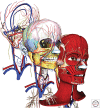Craniofacial Tissue Engineering
- PMID: 28348178
- PMCID: PMC5749148
- DOI: 10.1101/cshperspect.a025775
Craniofacial Tissue Engineering
Abstract
The craniofacial complex is composed of fundamental components such as blood vessels and nerves, and also a variety of specialized tissues such as craniofacial bones, cartilages, muscles, ligaments, and the highly specialized and unique organs, the teeth. Together, these structures provide many functions including speech, mastication, and aesthetics of the craniofacial complex. Craniofacial defects not only influence the structure and function of the jaws and face, but may also result in deleterious psychosocial issues, emphasizing the need for rapid and effective, precise, and aesthetic reconstruction of craniofacial tissues. In a broad sense, craniofacial tissue reconstructions share many of the same issues as noncraniofacial tissue reconstructions. Therefore, many concepts and therapies for general tissue engineering can and have been used for craniofacial tissue regeneration. Still, repair of craniofacial defects presents unique challenges, mainly because of their complex and unique 3D geometry.
Copyright © 2018 Cold Spring Harbor Laboratory Press; all rights reserved.
Figures



Similar articles
-
3D-Printing Technologies for Craniofacial Rehabilitation, Reconstruction, and Regeneration.Ann Biomed Eng. 2017 Jan;45(1):45-57. doi: 10.1007/s10439-016-1668-5. Epub 2016 Jun 13. Ann Biomed Eng. 2017. PMID: 27295184 Free PMC article. Review.
-
Craniofacial bone tissue engineering.Dent Clin North Am. 2006 Apr;50(2):175-90, vii. doi: 10.1016/j.cden.2005.11.003. Dent Clin North Am. 2006. PMID: 16530056 Review.
-
Advances and Prospects in Materials for Craniofacial Bone Reconstruction.ACS Biomater Sci Eng. 2023 Aug 14;9(8):4462-4496. doi: 10.1021/acsbiomaterials.3c00399. Epub 2023 Jul 20. ACS Biomater Sci Eng. 2023. PMID: 37470754 Review.
-
Taking bone grafts from the anterior and posterior ilium--tools and techniques: II. A 6800-case experience in maxillofacial and craniofacial surgery.Plast Reconstr Surg. 2005 Oct;116(5 Suppl):25S-37S. doi: 10.1097/01.prs.0000173951.78715.d7. Plast Reconstr Surg. 2005. PMID: 16217442 No abstract available.
-
Concise review: personalized human bone grafts for reconstructing head and face.Stem Cells Transl Med. 2012 Jan;1(1):64-9. doi: 10.5966/sctm.2011-0020. Epub 2011 Dec 7. Stem Cells Transl Med. 2012. PMID: 23197642 Free PMC article. Review.
Cited by
-
Spatial Distributions, Characteristics, and Applications of Craniofacial Stem Cells.Stem Cells Int. 2020 Aug 29;2020:8868593. doi: 10.1155/2020/8868593. eCollection 2020. Stem Cells Int. 2020. PMID: 32908545 Free PMC article. Review.
-
Degradation of Poly(ε-caprolactone) Resorbable Multifilament Yarn under Physiological Conditions.Polymers (Basel). 2023 Sep 19;15(18):3819. doi: 10.3390/polym15183819. Polymers (Basel). 2023. PMID: 37765673 Free PMC article.
-
Harnessing fine fibers in decellularized adipose-derived matrix for enhanced adipose regeneration.Mater Today Bio. 2024 Jan 25;25:100974. doi: 10.1016/j.mtbio.2024.100974. eCollection 2024 Apr. Mater Today Bio. 2024. PMID: 38322660 Free PMC article.
-
Artificial decellularized extracellular matrix improves the regenerative capacity of adipose tissue derived stem cells on 3D printed polycaprolactone scaffolds.J Tissue Eng. 2021 Jun 28;12:20417314211022242. doi: 10.1177/20417314211022242. eCollection 2021 Jan-Dec. J Tissue Eng. 2021. PMID: 34262685 Free PMC article.
-
3D printed composite scaffolds with dual small molecule delivery for mandibular bone regeneration.Biofabrication. 2020 Jun 12;12(3):035020. doi: 10.1088/1758-5090/ab906e. Biofabrication. 2020. PMID: 32369796 Free PMC article.
References
-
- Abukawa H, Zhang W, Young CS, Asrican R, Vacanti JP, Kaban LB, Troulis MJ, Yelick PC. 2009. Reconstructing mandibular defects using autologous tissue-engineered tooth and bone constructs. J Oral Maxillofac Surg 67: 335–347. - PubMed
-
- Abzhanov A, Rodda SJ, McMahon AP, Tabin CJ. 2007. Regulation of skeletogenic differentiation in cranial dermal bone. Development 134: 3133–3144. - PubMed
-
- Agata H, Watanabe N, Ishii Y, Kubo N, Ohshima S, Yamazaki M, Tojo A, Kagami H. 2009. Feasibility and efficacy of bone tissue engineering using human bone marrow stromal cells cultivated in serum-free conditions. Biochem Biophys Res Commun 382: 353–358. - PubMed
-
- Akintoye SO, Lam T, Shi S, Brahim J, Collins MT, Robey PG. 2006. Skeletal site-specific characterization of orofacial and iliac crest human bone marrow stromal cells in same individuals. Bone 38: 758–768. - PubMed
Publication types
MeSH terms
Grants and funding
LinkOut - more resources
Full Text Sources
Other Literature Sources
Medical
